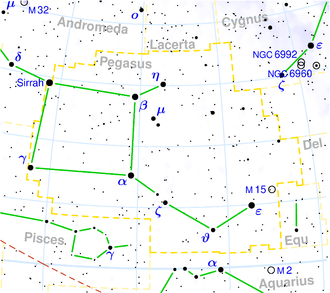NGC 7659
| Galaxie NGC 7659 | |
|---|---|
![NGC 7659[1]](http://upload.wikimedia.org/wikipedia/commons/thumb/b/b4/NGC7659_-_SDSS_DR14.jpg/300px-NGC7659_-_SDSS_DR14.jpg) | |
| NGC 7659[1] | |
| AladinLite | |
| Sternbild | Pegasus |
| Position Äquinoktium: J2000.0, Epoche: J2000.0 | |
| Rektaszension | 23h 25m 55,683s[2] |
| Deklination | +14° 12′ 35,39″ [2] |
| Erscheinungsbild | |
| Morphologischer Typ | S0/a [2][3] |
| Helligkeit (visuell) | 14,2 mag [3] |
| Helligkeit (B-Band) | 15,1 mag [3] |
| Winkelausdehnung | 0,8' × 0,3' [3] |
| Positionswinkel | 110° [3] |
| Flächenhelligkeit | 12,5 mag/arcmin² [3] |
| Physikalische Daten | |
| Zugehörigkeit | Abell 2593 [2] |
| Rotverschiebung | 0.013232 ± 0.000120 [2] |
| Radialgeschwindigkeit | 3967 ± 36 km/s [2] |
| Hubbledistanz vrad / H0 | (185 ± 13) · 106 Lj (56,6 ± 4,0) Mpc [2] |
| Geschichte | |
| Entdeckung | William Herschel |
| Entdeckungsdatum | 16. Oktober 1784 |
| Katalogbezeichnungen | |
| NGC 7659 • UGC 12595 • PGC 71417 • CGCG 431-064 • 2MASX J23255568+1412352 • GC 4961 • H III 212 • h 2239 • GALEXASC J232555.63+141235.6 • WISEA J232555.69+141235.3 • LDCE 1581 NED004 | |
NGC 7659 ist eine linsenförmige Galaxie vom Hubble-Typ S0/a im Sternbild Pegasus am Nordsternhimmel. Sie ist schätzungsweise 185 Millionen Lichtjahre von der Milchstraße entfernt und hat einen Durchmesser von etwa 40.000 Lichtjahren.
Im selben Himmelsareal befinden sich u. a. die Galaxien NGC 7649, NGC 7651, IC 5319.
Das Objekt wurde am 16. Oktober 1784 von Wilhelm Herschel entdeckt.[4]
Weblinks
Einzelnachweise
Auf dieser Seite verwendete Medien
Autor/Urheber: Sloan Digital Sky Survey, Lizenz: CC BY 4.0
The sky image is obtained by Sloan Digital Sky Survey, DR14 with SciServer.
Angle of view: 4' × 4' (0.3" per pixel), north is up.
Details on the image processing pipeline: https://www.sdss.org/dr14/imaging/jpg-images-on-skyserver/



